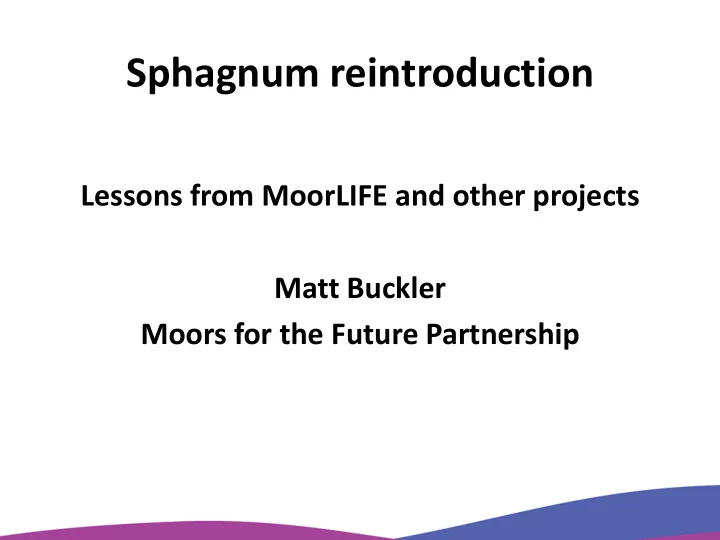

Sphagnum reintroduction Lessons from MoorLIFE and other projects Matt Buckler Moors for the Future Partnership
MoorLIFE/ MMU Sphagnum seminar
MoorLIFE/ MMU Sphagnum seminar Aims • Why is Sphagnum important? • Put Sphagnum reintroduction into context – why are we where we are? • What work is currently being done and what are we currently doing at a landscape scale • What are the challenges and opportunities over the next 10- 20 years? • 2 workshops – focussing on current conservation actions and research and monitoring activities and questions
Why is Sphagnum important? • Blanket bogs in the UK are Sphagnum
Why is Sphagnum important? • Blanket bogs in the UK are Sphagnum
Why is Sphagnum important? • Blanket bogs in the UK are Sphagnum • Blanket bog is a rarer habitat than tropical rainforest • More carbon stored in UK’s peat than in all forests in UK, France and Germany • Intact moors act as a filter for drinking water – Peak District and South Pennines supply drinking water to about 10 million people • Intact moors slow the flow of rainfall into streams and rivers – beneficial for flooding and drought alleviation • Industrial pollutants are stored within the peat
Why do we need to reintroduce it?
Why do we need to reintroduce it? 2008 MFFP report: “Past damage probably main factor preventing recovery in South Pennines”
How are people reintroducing Sphagnum?
Sphagnum rich brash • Lots of bare peat sites use heather brash for stabilisation – is Sphagnum introduced when this is cut from Sphagnum rich areas?
Sphagnum fragments • Small pieces of plant material added • Requires suitable source of material • More susceptible to drying out, works well in wet areas • Can be mulched with brash • Commonly used in cut-over raised bog restoration
Sphagnum fragments
Whole Sphagnum plants - hummocks • Collect material in handfuls and transplant whole handful to form new colony • Can be within sites or moving from one site to another • Can be done with flush or hummock forming species • Requires sustainable source of material
Whole Sphagnum plants - hummocks
Sphagnum propagation • Developed by Micropropagation Services, through discussions with MFF and MMU, due to absence of material in Dark Peak • Requires very small amount of source material, bulked up through micro-propagation • Most expensive techniques • Any species or combination possible • Beads, slime and plugs to date
Sphagnum propagation
Sphagnum seminar – Barriers to progress 1. Where are the sources of Sphagnum , including what is the impact of collection on donor sites and how much can be taken? Where can Sphagnum be collected from for adding to protected sites? 2. Coping with the long timescales for changes to become apparent 3. What is the end point we want? What trajectory will the vegetation on a site follow? 4. Will there be long term funding as re-establishing Sphagnum to a large area will be a long term project? 5. Can this be done at a very large scale with little follow-up possible? 6. What impact will a Sphagnum sward have on water quality or flows? 7. How can we show the importance to Sphagnum to private owners and tenants? 8. How can we make the public aware of the importance of Sphagnum ?
What are MFFP doing?
MoorLIFE Sphagnum • Bead application – Black Hill, Bleaklow, Rishworth Common, Turley Holes • Plug plants – Bleaklow • Sphagnum rich brash – Rishworth Common • Hummocks – Bleaklow • Sphagnum cuspidatum fragments – Bleaklow • Applied to over 900 hectares
Other MFFP Sphagnum Catchment Restoration Fund • What impact does Sphagnum dominated sward have on water quality and flow? Sphagnum / Molinia trials • 2012 – NE requested development of techniques for diversifying Molinia grassland with Sphagnum
Other MFFP Sphagnum Raising awareness New App FSC Field Guide Articles and publications
Thank you More information: matt.buckler@peakdistrict.gov.uk Moors for the Future Partnership Website: moorsforthefuture.org.uk Facebook: Moors for the Future Twitter: @moorsforfuture/ @moorsman
Recommend
More recommend